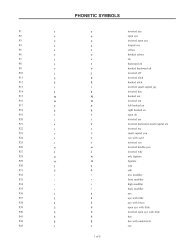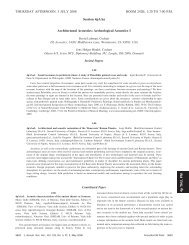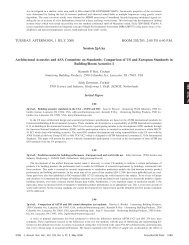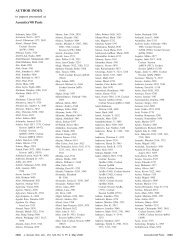Tuesday afternoon, 11 November - The Acoustical Society of America
Tuesday afternoon, 11 November - The Acoustical Society of America
Tuesday afternoon, 11 November - The Acoustical Society of America
You also want an ePaper? Increase the reach of your titles
YUMPU automatically turns print PDFs into web optimized ePapers that Google loves.
music” presents a set <strong>of</strong> challenges with regard to human-computer and interperformer interaction—particularly in the context <strong>of</strong><br />
improvisation. This paper discusses the limitations as well as newfound freedoms that can arise in the construction <strong>of</strong> musical performance<br />
systems that merge the paradigms <strong>of</strong> laptop music and network music. Several such systems are presented from personal work<br />
created over the past several years that consider the meaning <strong>of</strong> digital music collaboration, the experience <strong>of</strong> sound-making in remote<br />
physical spaces, and the challenge <strong>of</strong> improvising across time and space with limited visual feedback. <strong>The</strong>se examples include shared<br />
audio processing over high-speed networks, shared control <strong>of</strong> locally generated sound synthesis, working with artifacts in lowbandwidth<br />
audio chat clients, and the use <strong>of</strong> evolutionary algorithms to guide group improvisations.<br />
3:10—3:30 Break<br />
3:30<br />
2pMU5. Historical perspectives and ongoing developments in telematic performances. Scot Gresham-Lancaster Media and<br />
Technol. Services, California State Univ. Hayward, 25800 Carlos Bee Blvd., Hayward, CA 94542<br />
This paper presents historical perspective on development 8232, and new technology applications for performances in which the<br />
author collaborated with several other dancers, musicians, and media artists to present synchronized colocated concerts at two or more<br />
sites. This work grew out <strong>of</strong> the author’s participation in the landmark computer music ensemble, “<strong>The</strong> HUB.” Each <strong>of</strong> the various<br />
performances was made possible by an evolving array <strong>of</strong> videoconferencing hardware and s<strong>of</strong>tware. <strong>The</strong>se will be discussed, as well a<br />
look back at the early history <strong>of</strong> “telematic” performance. <strong>The</strong> problems and interesting side effects presented by latency and dropouts<br />
are a unique part <strong>of</strong> this performance practice. This work leverages the concepts <strong>of</strong> shared space, and video and audio feedback generate<br />
with evolving forms created by the combinations <strong>of</strong> the space, the sounds, and the movements <strong>of</strong> the participants. <strong>The</strong> ubiquity <strong>of</strong><br />
broadband Internet connections and the integration and constant improvement <strong>of</strong> videoconferencing s<strong>of</strong>tware in modern operating systems<br />
make this unique mode <strong>of</strong> performance an essential area <strong>of</strong> research and development in new media performance. <strong>The</strong>se new<br />
techniques will be discussed as well.<br />
3:55<br />
2pMU6. Telematic performance in mixed realities: Virtual and acoustic spaces. Pauline Oliveros Arts Dept., Rensselaer Polytecnic<br />
Inst., <strong>11</strong>0 Federal St., Troy, NY 12680, olivep@rpi.edu<br />
Performers are always dealing with latencies. Some <strong>of</strong> the smaller latencies are long forgotten and integrated into performance<br />
practice. Spaces new to performers always present challenges. Halls can be too dry giving the performer insufficient feedback to create<br />
a warm instrumental sound or in the other extreme too wet so that the clarity <strong>of</strong> the sound is blurred in the reverberations. Networked<br />
performances between two or more locations present new challenges and latencies. <strong>The</strong> mixed realities <strong>of</strong> networked performance<br />
spaces will be explored in this paper. How can performers adjust to receiving from and projecting sound into more than one space<br />
simultaneously? Where is the focus point when two or more spaces meet in a network? How can the ambiguity <strong>of</strong> simultaneous spaces<br />
provide creative inspiration for new acoustical forms?<br />
4:20<br />
2pMU7. Constructing an integrated system for the practice <strong>of</strong> playing<br />
the guitar. Mamoru Ichise Graduate School <strong>of</strong> Sci. and Technol., Ryukoku<br />
Univ., Japan, Norio Emura Doshisha Univ., Japan, Masanobu Miura<br />
Ryukoku Univ., Japan, and Masuzo Yanagida Doshisha Univ., Japan<br />
Constructed here is an integrated system for the practice <strong>of</strong> playing the<br />
guitar for novice guitar players. Novice guitarists for popular music <strong>of</strong>ten<br />
give up playing it because they cannot keep practicing for the difficulty <strong>of</strong><br />
realizing finger positions. An algorithm YG for giving optimal chord-form<br />
sequence for given chords was proposed Emura et al., AST, 104–107<br />
2006. Authors construct an integrated system for guitar practicing by<br />
implementing YG. <strong>The</strong> new system deals with thousands <strong>of</strong> MIDI files combined<br />
with names <strong>of</strong> chords for them. <strong>The</strong> proposed system shows chord<br />
sequences as the TAB score, with corresponding fingerings generated by YG<br />
as the chord diagram. By using the system, users are able to play excerpts<br />
using not the difficult but simple pattern <strong>of</strong> chord-form. <strong>The</strong> system interacts<br />
with the user playing the MIDI guitar by showing the performed notes with<br />
an accompanying playback for current excerpt. <strong>The</strong> user is expected to be<br />
supported on playing it under a performance evaluation, where errors <strong>of</strong> fingerings<br />
are simultaneously shown with accompanying playback stopping or<br />
slowing down. <strong>The</strong> performance <strong>of</strong> the system is confirmed as better than<br />
the usual style <strong>of</strong> practicing in terms <strong>of</strong> occurrence frequency <strong>of</strong> errors.<br />
Work supported by HRC, Ryukoku University.<br />
Contributed Papers<br />
4:35<br />
2pMU8. New musical interface for playing the guitar solo. Sangjin Cho<br />
School <strong>of</strong> Elec. Eng., Univ. <strong>of</strong> Ulsan, Ulsan 680-749, Korea,<br />
sjcho75@ulsan.ac.kr, Myeongsu Kang, and Uipil Chong Univ. <strong>of</strong> Ulsan,<br />
Ulsan 680-749, Korea<br />
This paper describes the development <strong>of</strong> a new musical interface to play<br />
guitar solo with the nonstringed guitar. <strong>The</strong> previous work <strong>of</strong> authors is the<br />
implementation <strong>of</strong> the nonstringed guitar comprised <strong>of</strong> laser strings and a<br />
chord glove J. Acoust. Soc. Am. 122, 3055 2007. It is hard to express<br />
guitar solo, so voltage dividers are set up on the neck to represent frets. In<br />
the case <strong>of</strong> the chord glove, the same voltage source <strong>of</strong> the TMS320F2812 is<br />
supplied instead <strong>of</strong> attaching force sensing registers to the fingertip. Consequently,<br />
there are three essential components for the proposed interface:<br />
voltage dividers, laser strings, and the chord glove. Voltage dividers replace<br />
the six strings on the neck and send fret information to DSP, laser strings<br />
represent strokes, and the chord glove expresses playing chords and solo.<br />
This proposed interface represents many kinds <strong>of</strong> playing styles. In the case<br />
<strong>of</strong> hammering on, pulling <strong>of</strong>f, and sliding, it needs fret information from<br />
voltage divider to express these things. On the other hand, bending that varies<br />
the pitch in a fret needs to detect how much flex sensors are bent to play.<br />
Work supported by the Korea Research Foundation Grant funded by the<br />
Korean GovernmentMOEHRDKRF-2006-521-H00002<br />
2490 J. Acoust. Soc. Am., Vol. 124, No. 4, Pt. 2, October 2008 156th Meeting: <strong>Acoustical</strong> <strong>Society</strong> <strong>of</strong> <strong>America</strong><br />
2490







